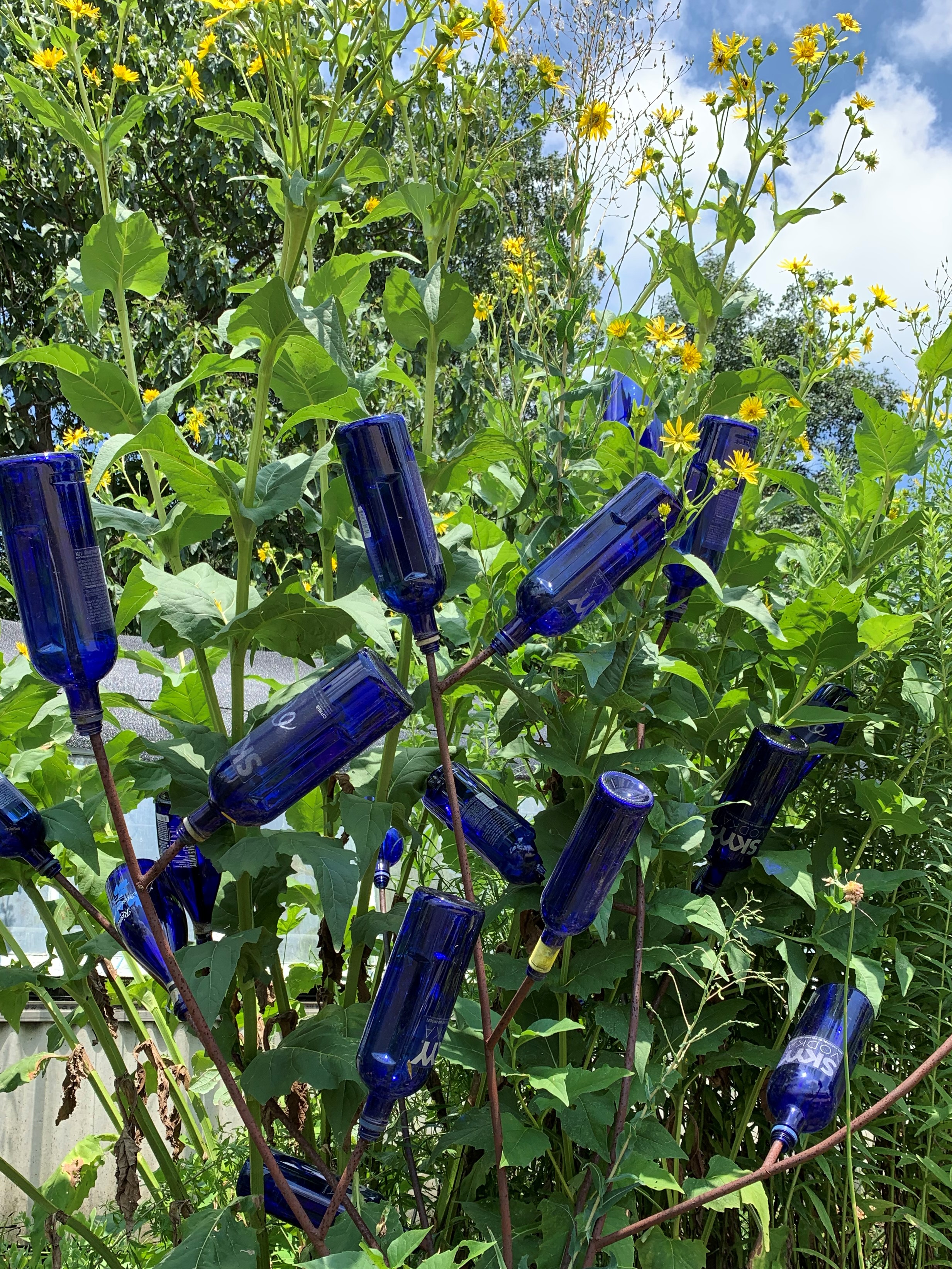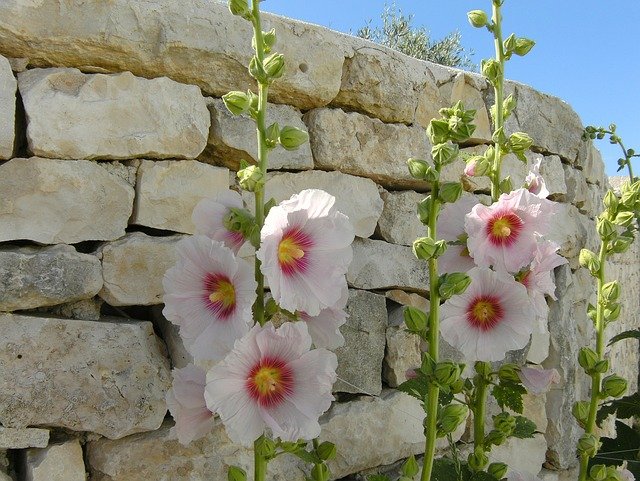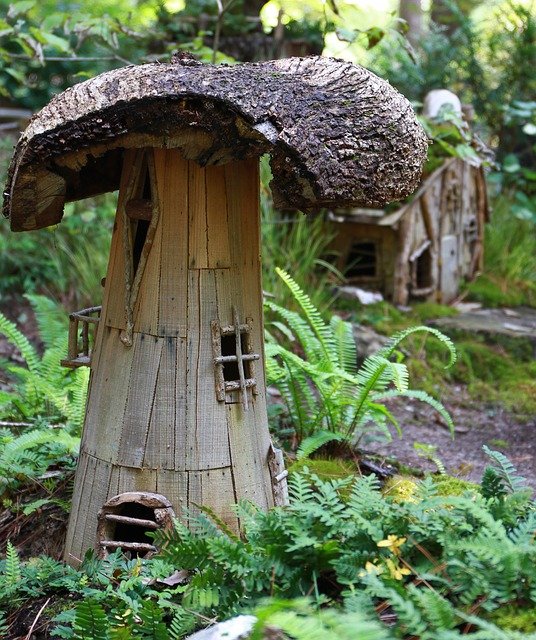Just as gardener P. Allen Smith likes to promote the use of “garden rooms,” I enjoy creating garden themes, which is a similar concept. This is an effective way for a beginning gardener to plan out a garden. You simply choose a theme.
Themes can vary – they can be based on color, country or state, animal, medicinal, cooking, or even age. Only your imagination limits your themes.
Specific Colored Gardens: I love the color blue and have, in the past, created a monochromatic blue garden. Of course, there is little blue in nature, so I have used plants that bloom “close to blue” such as lavender, butterfly bush, Russian sage, and false indigo. It is really a challenge for me to find plants that fit this color requirement. I use blue accessories to emphasize the color such as a blue bottle tree. I have recently added the color cranberry to what was a monochromatic garden. But the garden is still color themed. Plantings around Blue Star Memorials are often red, white, and blue; thus, are color-themed gardens.

Memory Gardens: My friend had a “grandmother’s garden” which contained plants that reminded her of her grandmother. These included old fashioned roses, hollyhocks, and lilacs. She even had a scarecrow grandmother. Memory gardens often surround a tree planted in memory of someone. Using plants that your loved one had in his or her garden is a wonderful way to remember your loved ones.

Location Gardens: We have all seen a Japanese or an English garden. I have a “West Virginia garden” which is a garden in the shape of my state. In that garden I use plants that tend to be gold and blue, the color of my alma mater, West Virginia University. I use lots of steppingstones that are WV themed. I have created my own little New River with a little New River Gorge Bridge in this garden. I have used large rocks as mountains since West Virginia is the “Mountain State.”
Medicinal Gardens: This is self-explanatory and uses such plants such as bergamot, cohosh, chamomile, echinacea, feverfew, St. John’s wort, and hyssop.
Salsa or Pizza Garden – These gardens grow things you like to eat. A pizza garden would have peppers, onions, tomatoes, and oregano. A salsa garden typically has cilantro, garlic, peppers, and tomatoes. These are wonderful ways to involve children in gardening.
Rock Gardens: I collect rocks from different travels, hopefully all legally obtained. With those rocks you could create a rock garden which usually uses sedums as the plants growing between the rocks. This garden will remind you of your travels.
Pollinator Gardens: Most gardeners have pollinator gardens. These gardens include plants that attract pollinators such as milkweed for monarch butterflies and bee balm for bees. Wildlife gardens are similar in that they contain plants and features that attract wildlife. Many states and organizations have programs to certify such gardens, including signage.
Water Gardens: These are gardens that typically contain a water feature, or they can be gardens planted in wet areas. Usually, these gardens contain water plants such as water lilies in ponds, iris plants, and pitcher plants.
Same plant gardens: These are gardens that have different varieties or cultivars of the same plant. An example is a hosta garden. This garden can contain dwarf and regular sized hostas of varying colors, including variegated and non-variegated plants.
Fairy Gardens: I have a fairy garden that consists of a door on the bottom of a tree. Outside of the door stands a gnome. I try to use dwarf or small plants in this little area such as sweet alyssum and dwarf hostas. I have seen children slow down to look at this garden that is close to the road, which delights me.

Children’s Gardens: This is one of my favorite theme gardens. Use plants, with labeled signage, with fun names such as pussy toes, baby’s breath, and snapdragons. Consider using plants that are fun to touch such as lamb’s ear. I once created a children’s book garden for our local library, using signage that lifted quotes from children’s books and had the plants mentioned in those quotes such as “Wind in the Willows” or “Peter Rabbit.”
This article could go on and on listing ideas for themes. I do encourage using native plants and noninvasive plants when planning your themed gardens.
National Garden Clubs, Inc. is a 501(c)(3) organization that aims to promote the love of gardening, floral design, and civic and environmental responsibility. There is a local club near you, click here to find one and join. Subscribe to the NGC’s blog by entering your e-mail here. You will receive an e-mail when there is a new blog article on the NGC website. You do not have to be an NGC member to subscribe.
10 Comments
Great way to start
Thank you, Brenda. What a wonderful way to “compose” plantings.
VP
Brenda, such a lovely garden! I agree a garden theme is a good way to start a garden. You never know where your imagination will take you. Thank you for your inspiration!
Gardener
Brenda very nice, thank you!
Children’s theme
Love that children’s garden and the ideas for the plants.
CGCI Social Media Chairman
Just shared the blog address on California Garden Clubs, Inc.'s Facebook page. GREAT ARTICLE.
Star Trek Gardener
I have a Star Trek garden laid out in the symbol of the Star Trek Federation. Twenty five daylilies have Star Trek names such as Vulcan Ears, The Tribble With Blue, and Borg Technology. I also have 12 Hosta and six iris with Star Trek names.
Ideas
Wonderful range of ideas! Thank you!
Green Thumb VP
Great ideas for theme gardens. Thank you. I, too, enjoy creating them.
Some of mine are butterfly garden, hummingbird garden, spring ephemeral bed, cottage garden, rose and perennial garden, and a red and yellow garden.
NGC first vice president
Thank you for your kind comments and even sharing your ideas on this topic. I appreciate it.
Morning Garden Club
Really interesting, and I love your blue bottle tree! Thanks!

 Board Member Login
Board Member Login Our Store
Our Store Blog
Blog





